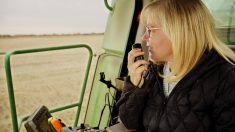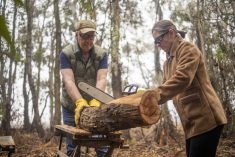In south central Manitoba a couple we’ll call Harry and Ella, both 64, face the challenge of transferring their 3,500 acre mixed grain and 400 cow operation to their three children. The problem is that two of the children, each in the 30s, don’t want to farm.
It’s a good business worth about $4 million. Yet entrusting the operation to the kids is dicey, for the eldest, 38, has his own business and is not interested in farming. A middle child, 32, is unwise with money and is not a good bet to run the farm. Only the youngest child, 29, has the personality and track record to run the business. He works for Harry and Ella, and, as well, runs his own farm. They expect to take over the parents’ farm one day. The question is how get from here to there.
Read Also

Gentle treatments for pain in the neck
Heading toward year-end, people unknowingly tense up against the cold and busyness, causing neck pain that can often be treated with appropriate support and gentle mobility, athletic therapist Kathlyn Hossack says.
Farm Financial Planner asked Don Forbes and Erik Forbes of Don Forbes Associates Inc./Armstrong & Quaile Inc. in Carberry, Manitoba, to work with Harry and Ella. “The situation is a paradox,” Don says. “The most logical and even the easiest solution is to sell and invest the money in stocks and bonds for, say, five per cent a year before tax. That would be a $200,000 pre-tax living.” The farm would be eligible for the lifetime $800,000 individual farm property capital gains exemption. That would apply to each partner and eliminate capital gain tax risk altogether, he explains.
- More ‘Farm financial planning’ on Grainews: Slash your tax bill by transferring the farm
Sale outside of the family would destroy the farm as a legacy. So the problem is how to keep the farm in the family, ensure its wise operation, look after the two children who will not farm and keep the parents in sufficient funds to have a pleasant and secure retirement.
Best bet: create a family trust to run the farm. It can have family members as trustees and outside advisors can be trustees as well. The family trust would be taxed at the highest personal tax rate, so it would have no direct financial advantage, Erik Forbes notes. Yet the trust would be multi-generational, would be a formal arrangement that would require accounting and, if necessary, be reviewable by a court. It could ease generational transition when Harry and Ella pass away.
Harry and Ella want $4,000 a month before tax for their retirement. However, squeezing that return out of the operation will be tough. Harry and Ella have $414,000 of non-registered assets and Tax-Free Savings Accounts. Those assets, which are mostly mutual funds, can generate five per cent a year before tax or $20,700 annually. That works out to $1,725 a month. $4,000 a month remains a distant target. If they add another $300,000 to capital, grow the assets at six per cent per year before inflation or tax and arrange payouts so that all income and capital is consumed by age 90, their financial assets would generate $52,700 a year or $4,400 a month before tax, Erik Forbes estimates. Cash for the investments will have to come from taxable investments or farm assets, for the couple has neither RRSPs nor TFSAs.
That’s not all. Harry and Ella also want a new house off the farm. That would be a $300,000 expense. Yet squeezing that amount of money out of current farm income is not possible. Recently, the farm has not been profitable. It produces just $60,000 of taxable income for the couple.
To achieve the $60,000 pre-tax income stream and to take $300,000 out of the farm for a new, off-farm house requires a partial sale of assets. The easiest move: sell the cow herd. It has an estimated value of $600,000. It is a high value product, but it is easily replaceable and, with the animals gone, the farm would be a grain operation that is relatively easy to manage.
In retirement, Harry and Ella will have permanent monthly income totaling $5,890 before tax composed of $4,400 from investments, two $558 monthly Old Age Security cheques, and two Canada Pension Plan cheques totaling $374. After age and pension credits, splitting of CPP benefits, provincial tax credits for seniors and zero tax on Tax-Free Savings Account payouts, income tax would average about 12 per cent, Don Forbes estimates. They would have $5,182 a month after tax.
Getting there from here
First, Harry and Ella should each fill their TFSA cumulative space with $31,000 of available cash. In January, 2015, they can add another $5,500 each.
The last question is the cost base that Harry and Ella will leave with the farm. It is currently low with the cattle herd fully amortized plus $400,000 for land, buildings and equipment. If the farm transfers to the trust, each beneficiary of the trust could utilize his or her capital gains exemption and eliminate almost all capital gains tax at disposition. Thus the next generation would be able to add capital value to the initial $4 million and not have to worry about capital gains tax on partial sale of some of the farm assets. The arithmetic is, in fact, benevolent, for five times the $800,000 exemption per person (the parents and the three children) is the present value of the farm, $4 million.
Harry and Ella say that they want to quit the farm, but chances are they will remain close to it. If the trustees agree, the parents could provide advice and guidance and receive a fee for their services.
As the reorganization of the farm and its management proceeds, the operation can be restructured as three operations: 1) the grain and grazing operation, 2) the cattle operation and 3) farm equipment and the farm house. Each asset class can generate income.
The grain and grazing component is relatively easy to manage. The farm could lease out the land and take rent rather than profit. The cow operation takes more management but is potentially a high value added business, which can take in more animals or lease animals to neighbours. The farm house is a primary residence and will appreciate tax-free. The equipment can be depreciated.
“This solution offers the combination of perpetuation of the family farm under the control of a family trust, a flexible family-wide management plan within the trust, the ability to shift assets between the identified business components and a way of extracting money to bolster the capital Harry and Ella need to generate retirement income while also providing for a new farm house. It is low risk, it is transparent, it will tend to keep intra-family conflicts to a minimum and it preserves the interests of two non-farming children,” Don Forbes adds.
Will the plan fly? The immediate need is for Harry and Ella to convene a family meeting to assess everyone’s needs, Erik Forbes says. The plan has to be explained, the role of the trust as a bridge over generational transfer has to be explained and accepted, and the costs in time and money for trust governance also have to be made clear.
The trust concept means that there will be no disposal of the farm to strangers. So for the good of the farm and for the good of the family, the way the trust works, who will serve as trustees, who will audit the trust, and who will handle tax management also need to be discussed.
“The plan is an agreement for the future,” Don Forbes explains. “You could say that, because it leaves so much in place that it is no solution at all. Yet the beauty of the plan is that it requires nothing but cooperation. It leaves the farm much as it is and provides for the needs of everyone.”














